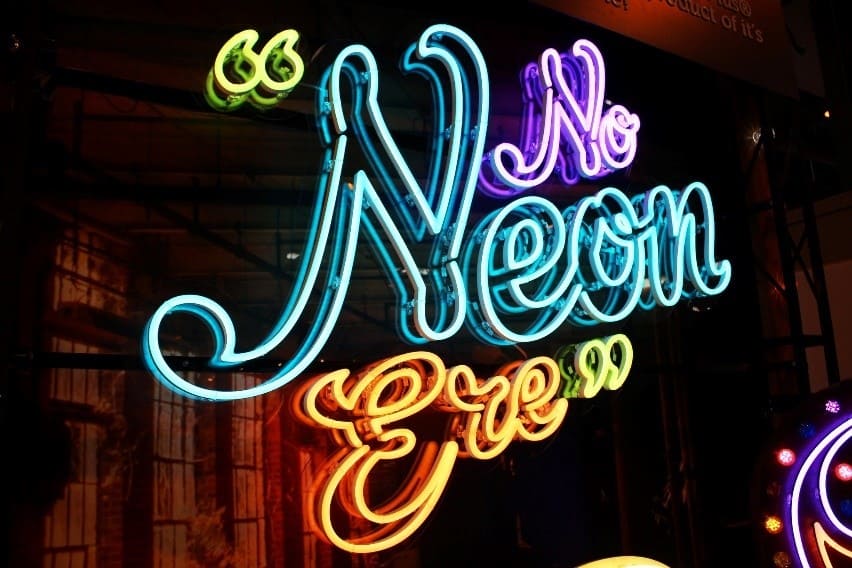Neon vs LED neon—how do they compare?
NeonPlus® signs use LED neon technology. This looks almost identical to traditional neon but is much more flexible in terms of how it can be customised.
LED neon is also more energy efficient and environmentally friendly and has capabilities that traditional neon simply doesn’t—it can change colour, dim or create a strobe effect, for example.
On this page, we examine how the two compare, focusing on:
- Materials and components
- Technology
- Running costs
- Safety and environmental impact
- Flexibility of design
- Placement
LED neon vs traditional neon—materials and components
What are traditional neon signs made of?
A neon sign has the following main components:
- Tubes
Made of soft lead glass (crystal), these are heated, bent and twisted by hand, then cooled and fused together. They are later filled with various gases to achieve different colours.
- Electrodes
Pure-iron electrodes surrounded by a glass jacket are welded to both ends of the tube and wired to the transformer using high-voltage cables.
- Transformer
An electrical device that transfers from the mains to the electrodes the voltage needed to make the neon gas inside the fluorescent tubes glow. They work via a process known as electromagnetic induction.
- Backing panel/framework
Once made into the final design, the glass tubes are mounted to a backing panel or be supported by some kind of framework.
Small signs tend to have a steel framework, while larger displays are supported using wood, steel or aluminium.
What are LED neon signs made of?
LED neon (faux-neon) signs such as NeonPlus® use neither glass nor neon gas. Instead, they are made from acrylic—a thermoplastic better known as Altuglas or Perspex—which is lightweight, shatter-resistant and effective at transmitting light.
A typical LED neon sign has the following main components:
- Tubes
Cut from a solid block of opal acrylic then rounded and sanded, these hollow tubes house the LEDs.
- Edges
The acrylic tubes are finished with either blockout paint or vinyl edging to create the final design.
- LEDs
The LEDs (light emitting diodes) work as a semiconductor and are typically made of aluminium-gallium-arsenide.
They are embedded in close proximity to each other inside the acrylic tube and then wired up.
- Backing panel
If necessary for the final design, the tubes are mounted to a backing panel made of various materials including polycarbonate, acrylic and steel.
LED neon vs traditional neon—technology
How do traditional neon signs work?
Neon signs emit light as the result of a chemical reaction between the gas inside the glass tube and the electricity fed in through the metal electrodes.
These signs consist of glass tubes which are shaped into letters or decorative designs then filled with neon gas. When a high-voltage electrical current is passed through the gas, the neon tubing glows.
The process is explained in more detail here.
How does LED neon work?
Where neon relies on a reaction between the neon gas and electricity, with LED neon the reaction comes when electrons pass through a semiconductor, which is typically a material known as aluminium-gallium-arsenide.
When used in signs, the LEDs must be placed inside the tubes in the correct position. Too many LEDs in the same space will draw more electrical power and possibly cause hot spots (where the light becomes harsh and creates what appears to be a dotted pattern). Too few LEDs wrongly spaced and there will be black spots.
The LEDs must be positioned so they produce a steady source of light similar to the effect of neon gas glowing inside a glass tube.
LED neon vs traditional neon—running costs
One of the benefits of LED neon is the cost savings it provides. Because it runs on a far lower voltage than traditional neon, it’s much more energy-efficient and costs around 20% less to run. This is particularly true with larger signs and outdoor displays.
Another factor to consider is that LED neon signs require almost no maintenance, meaning you shouldn’t have to spend money on repairing or replacing components. As neon signs have a slightly longer lifespan, they are more likely to need maintaining at some point. Bear in mind that this maintenance must be carried out by a qualified professional, which will incur further costs.
LED neon vs traditional neon—safety and environmental impact
Neither traditional neon nor LED neon present a health risk or are particularly harmful to the environment. But there are certain differences in the technology that make LED neon that bit safer and more environmentally friendly.
Safety
LED neon has no need for potentially toxic gases or mercury. Neon signage, on the other hand, contains a very small amount of mercury, which they use to generate the particular colour of light. Indeed, it could soon be illegal to use toxic chemicals like mercury in neon signs, as there are steps being taken to enforce a ban and write it into sign industry regulations.
Neon gas is safe in very small amounts, but possibly dangerous if it leaks into the air because of damage to a glass tube, meaning there is a chance it could harm people’s health.
Impact on the environment
As an inert gas, neon is incapable of reacting with any other elements or chemicals, so it poses no threat to the environment that way.
However, because traditional neon lighting displays consume more power than alternatives like LED neon, the implications that arise with the use of electricity and its generation via fossil fuel power stations start to apply.
Another factor to consider is the use of precious metals and potentially toxic gases and how these must be disposed of correctly when a lighting display comes to the end of its usable life. Leaving them in a landfill, for example, brings with it a possible risk.
LED neon signs like NeonPlus® are around 80% more energy efficient than traditional neon signs, using far less power and giving off only an inconsequential amount of heat. As they also tend to made from materials which are fully recyclable, they have a smaller carbon footprint.
LED neon vs traditional neon—flexibility of design
Lighting changes
One major drawback of traditional neon is that once a sign has been manufactured and the fluorescent tubes have been filled with neon gas, there’s only one effect that the sign can achieve, and that’s to glow with a static single-colour illumination. Unfortunately, there’s no way to change the colour of the sign or have the light dim or flash.
With LED neon, however, everything is controllable using digital drivers. When connected to a sign, these devices are able to tell the LEDs what effect to display, whether it’s changing colour, strobing or dimming and brightening.
Read more about LED neon’s different lighting functions here
Designs
The way in which LED neon signs are manufactured mean they can be made to much more closely replicate a brand logo or a certain design. The glass tubes used in traditional neon signs can be shaped into similar designs, but with less accuracy.
LED neon vs traditional neon—placement
This comes down to personal preference. Both traditional neon signs and LED neon signs can be used indoors and outdoors without any issues, as you’ll know from seeing them as billboards adorning buildings in many major cities.
Related content
Neon signs—how they work, how they perform and are there alternatives?

